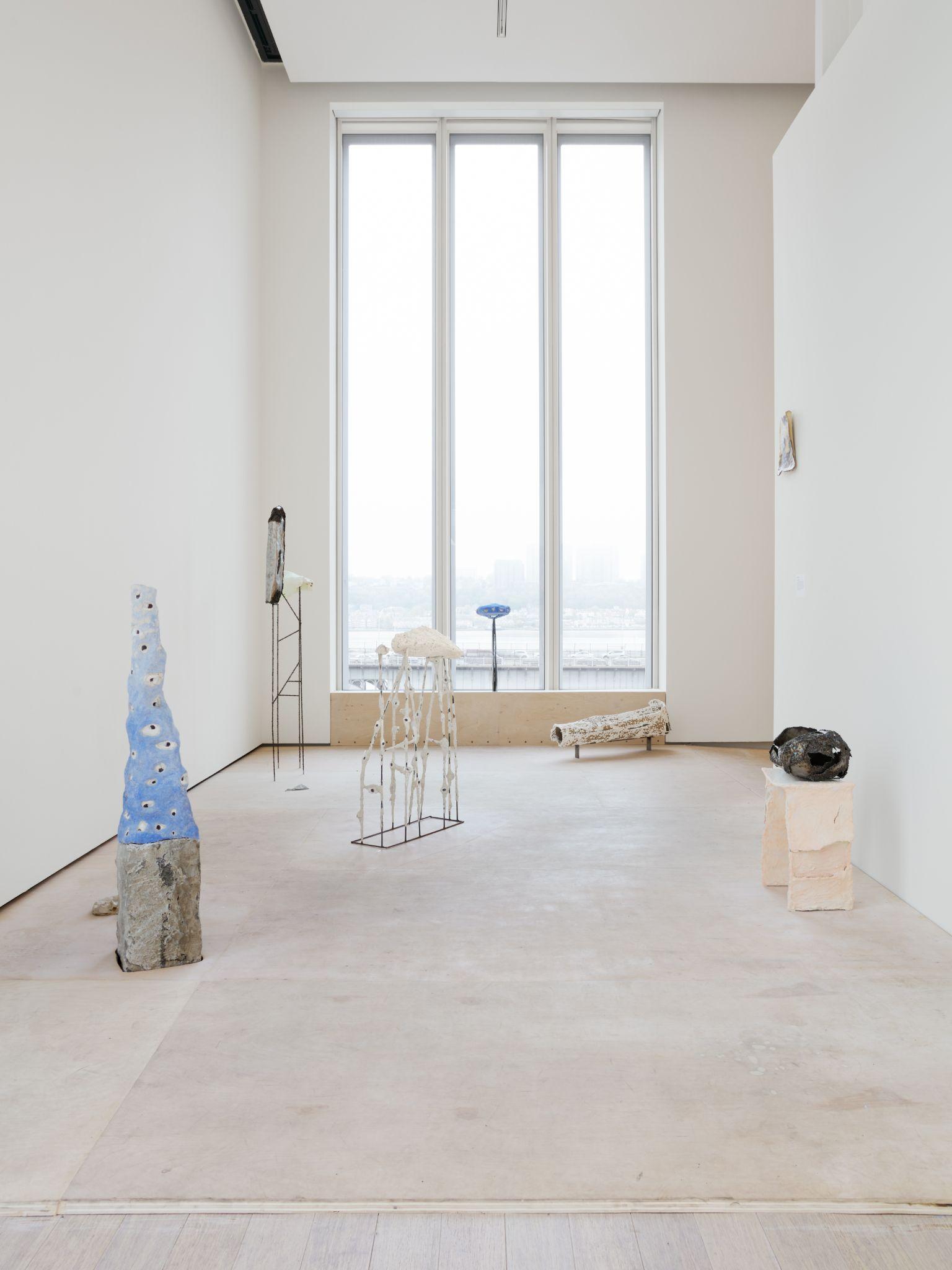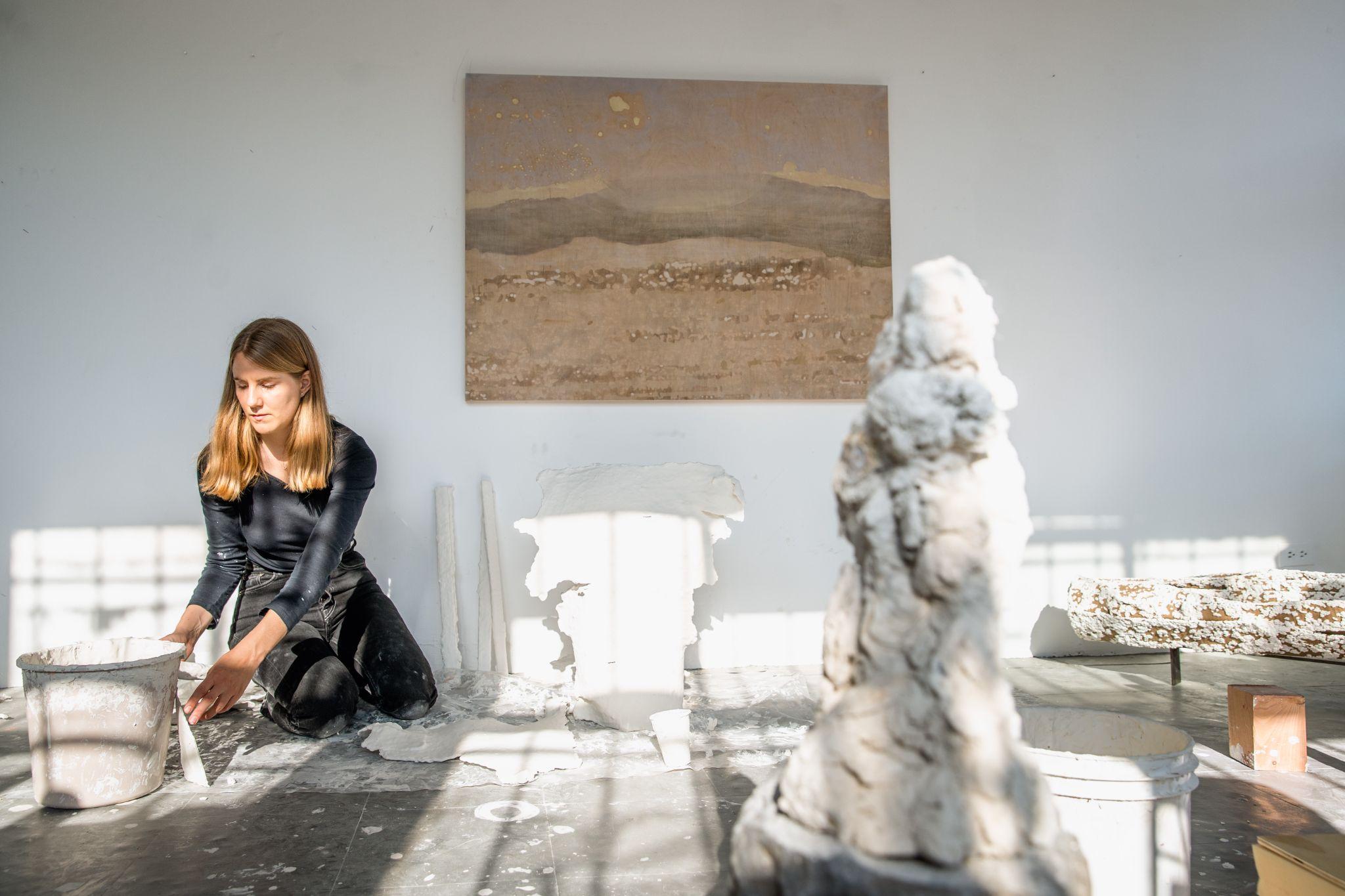Linnéa Gad’s Poetic Approach to Limestone


“I keep feeling that there needs to be a way out for my works—some way that they can eventually return to the life cycles of their materials,” Swedish U.S.-based artist Linnéa Gad writes to me in an email about her most recent work centering lime, as in limestone. What started as a strict prompt to only sculpt in different variations of lime—ranging from oysters that use the material to make their shells that protect their soft bodies and to lime mortar, and Onondaga and fossiliferous limestone—has expanded into a playful exploration of marine biogenic calcification. Continuing to reflect on the oyster shell and container materials her sculptures incorporate clay, metal, and paper. Works that hopefully soon will leave the confines of the gallery space onto the shorelines or streets.
We have moved in and out of each other’s lives for close to a decade, but more recently we are in touch frequently as I am curating her in The Immigrant Artist Biennial 2023: Contact Zone attempting to bring her work into public space.

A sculptor, Gad is not afraid to get her hands dirty and is apt at construction. In her ambitious MFA thesis show “Echo else” at Wallach Gallery she raised the floor by building a sloping wood platform against the backdrop of a window overlooking the Hudson River—her sculptures, like sea creatures, seemed to be either returning to or emerging from the water.
With the Billion Oyster Project, and perhaps The Immigrant Artist Biennial, she is working on bringing her material back to their life cycles. In her words “After making these sculptures of welded steel, covered in lime mortar and oyster shells. It occurred to me that they would function as great reef structures if they were thrown into the sea.” Exploring this idea, she has proposed to make sculptures that extend from floating metal gabion structures of oyster reefs at the shoreline that could visualize the presence of the reef below.
There are many unexpected objects posing as reefs in and around New York to help with underwater rehabilitation. Those who visited Ralph Rugoff’s “May You Live in Interesting Times” at the Venice Biennale in 2019 might remember Cyprien Gaillard’s moving video work Ocean II Ocean where, among other clips, MTA subway cars are dumped into the ocean. Disused New York subway cars provide a good surface for marine life to latch up on.
“The nature of this project is to recognize poetry in the possible, diverse lives of a material and how interwoven everything is,” Gad explains. Her use of Lapis Lazuli as a metamorphic transition of dolomite limestone to the blue mineral reflects the length at which the material can transform, “one possible outcome of limestone compressed on ocean floors is to turn into the radiant blue that has been used to depict the blue sea,” she explains.
Prehistoric humans collected oyster shells in large heaps—more recently, U.S. settlers harvested the natives’ shells’ structures in the absence of a local limestone quarry and made buildings with a so-called oyster tabby. “It was an extremely laborious building technique and relied upon slave labor. As a result of liberation the oyster tabby building technique completely disappeared,” she tells me having dived into the history of the material. Lime is also present in Swedish and Scandinavian architecture. The most common facade treatment in Stockholm, where Gad grew up, is made with a pigmented lime stucco in pastel colors. Gad’s book Kalk—the Swedish word for lime—will be published by RSS Press, a Danish press. The book is an interdisciplinary foray into lime where Gad’s writing oscillates between geology, anthropology, art history, ecocriticism and personal accounts.
Armed with the experience of project managing her own book, Gad taught an Artist’s Book class at her alma mater Columbia University School of The Arts this spring. An energizing experience. ”Teaching connects me with my younger self and the lessons that I learned to become an artist, by passing them on I let them invigorate my life again,” she says.

Gad describes her sculptures as memory palaces, “holding many different narratives and histories.” Her book is a way to unearth the histories and connection points of the material. “But also to let it stick together, to calcify!” she explains and I laugh.
Interestingly, as lime stabilizes pH levels in the ocean and marine organisms lock CO2 into the ocean floor her work follows the carbon cycle—lifecycles of materials. She looks to Rachel Carson’s environmental writing and how it successfully takes a big-picture overview of cause and effect. The climate crisis serves as a red thread throughout her practice.
When I first met Gad in 2016 she was engaged with the Anthropocene, back from New York, she was creating work out of a studio in the Swedish countryside. I visited her exhibition of paintings and sculptures in wood, cellulose sponges, and plaster installed in a bunker space—under the earth, from where much of the material originated. Using Timothy Morton’s Ecology Without Nature, she explored the delicate relationships between humans and their environment, extending into the history of landscape painting and the objectification of nature. Walking in the forest near her studio one day she realized that it was all planted and pondering the lack of biodiversity sparked her to think more about the problematic separation between nature and art.
We had a meaningful conversation about the climate crisis in this exhibition space blasted into the ground. We all have them, that moment when we come to terms with our own insignificance, an aid to navigating the world with less anxiety. Living in Shanghai, I realized that there are so many humans on this earth and my individual life does not really matter—collective action enacts real change. For Gad, it was sobering to realize that the earth does not really care about us or climate change. “There have been plenty of extinctions and this crisis is about saving humanity, not the earth,” she commented. Recalling the show she explains that she is now more critical to the idea of Anthropocene for its outsized perspective.
“My sister sometimes teases me that it takes very little for me to flip out over an outdoor experience in a new landscape and also how long a short exposure can sustain years of work and reflection,” Gad explains. She would love to spend more time in the North of Sweden or visit Karst limestone landscapes in China and the volcanic landscapes of Iceland but is also worried that these experiences might overwhelm her. For now, she lives between New York City and Woodstock, spending most of her time in her studio in Mt Tremper. “I am very moved by the soft mountains,” she says. Her studio occupies the ground floor of a white house with large barn doors, surrounded by mountain vistas. Across the road and a short way up a rocky hill she shares a welding workshop with her studio neighbor: “It is kind of a dream come true.” I have visited her there and I concur.
Being an artist can be lonely, especially if you are obsessive, like Gad. However, she has found a feedback loop participant and occasional collaborator in her partner Will Epstein who is a musician and composer. “When we have had the experience of a successful collaboration it is as if an extension of yourself with another set of skills chimes in, it is magical.” I saw them at the Jewish Museum last year—Gad worked with gestures and objects while Epstein created music. She explains that they are involved in each other’s work giving each other feedback, “I listen through something or he comes over for a studio visit but it is also kind of a day-to-day thing that I’m very grateful for.”

Gad’s work is both encompassing and very focused. She carries herself and her work with much poise and respects the process and her materials. The artist’s works have lives of their own, she believes in anthropomorphizing as a way to connect and feel empathy for material and aims for her audience to ponder how her materials live.
When I visited her previous studio one of her works had escaped. She laughs when I ask her to retell the story. Photographer Liz Deschenes was visiting her studio and commented on a work in the window whose personality reminded her of Joseph Beuys’ Lightning with Stag in Its Glare at Mass Moca—”a great title,” she adds. One day, the work was gone; studying pictures on her phone Gad pinpointed the time of disappearance and concluded that the piece had jumped out of the window. “It definitely was an experience where it felt like my work has agency for better or for worse.”
You Might Also Like
Idelle Weber and Aurora Robson’s Environmental Works at Hollis Taggart
George William Bell’s Lusty Anthropomorphism
Not Straightforward or Impossible: sgp in Conversation with Alina Yakirevitch
What's Your Reaction?
Anna Mikaela Ekstrand is editor-in-chief and founder of Cultbytes. She mediates art through writing, curating, and lecturing. Her latest books are Assuming Asymmetries: Conversations on Curating Public Art Projects of the 1980s and 1990s and Curating Beyond the Mainstream. Send your inquiries, tips, and pitches to info@cultbytes.com.

